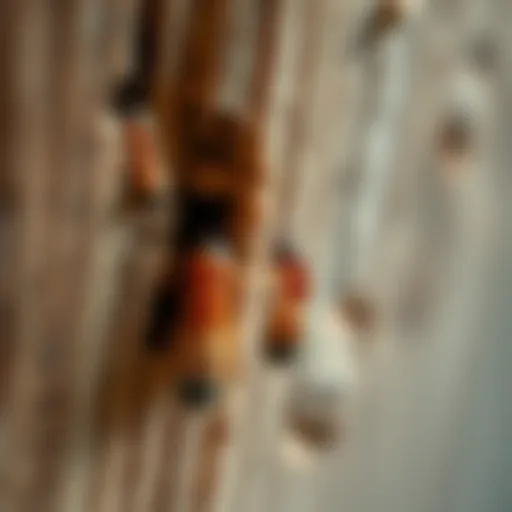Effective Home Remedies for Deterring Woodpeckers
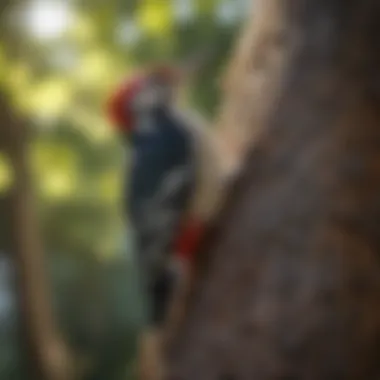

Intro
Woodpeckers, with their striking plumage and rhythmic drumming, often appeal visually. However, their tendency to peck at wooden structures can result in significant damage to homes. This guide provides a detailed exploration of effective remedies for homeowners facing the challenge of deterring these persistent birds. By delving into woodpecker behavior and ecological roles, we can better understand how to manage their presence humanely.
Understanding Pests
Definition of Pests
In the context of residential properties, pests refer to species that invade human habitats, causing damage or disturbance. Woodpeckers can be classified as pests when their foraging behavior leads to structural issues, such as hole drilling in siding or eaves. Understanding their habits and preferences is crucial for effective management.
Importance of Pest Identification
Identifying the type of woodpecker causing damage is the first step. Different species exhibit varied behaviors and preferences. For instance, the Downy Woodpecker is relatively small and typically feeds on insects hidden in trees or bark, while the larger Pileated Woodpecker may cause more sway to wooden structures. Knowing their behaviors guides homeowners in selection appropriate remedies and techniques for prevention.
Prevention Techniques
Home and Garden Preventative Measures
- Visual Barriers: Using physical barriers like bird netting can effectively deter woodpeckers from accessing vulnerable areas. Install this around eaves or windows to create an unwelcoming environment.
- Reflective Objects: Hanging reflective surfaces, such as aluminum foil or old CDs, can make your property less attractive. The reflections disturb the woodpecker’s sight, making them think twice before approaching.
- Feeding Alternatives: If your property has bird feeders, consider keeping them well-stocked with seeds that do not attract woodpeckers. Feeding options such as nyjer seeds are less appealing to these birds than suet.
Seasonal Prevention Tips
- Spring Audits: As woodpeckers tend to create nests during the early spring, undertake a thorough inspection of your property. Look for new holes and cover them promptly.
- Fall Maintenance: In autumn, ensure wooden structures are treated with paint or sealants to reduce susceptibility to pecking. A well-maintained surface is less appealing to foraging birds.
Eco-Friendly Pest Control Solutions
Overview of Sustainable Practices
Embracing an eco-friendly approach to pest control emphasizes humane and sustainable solutions. Utilizing natural materials and methods can enhance effectiveness without damaging the environment. In your quest to deter woodpeckers, it is crucial to explore these sustainable techniques that maintain ecological balance.
Natural Remedies and Their Effectiveness
- Spice or Citrus Sprays: Spraying a mixture of water and spices like cayenne pepper or citrus can create an unpleasant taste. These natural deterrents avoid harm while giving woodpeckers reason to stay away.
- Garlic Solution: A spray made from diluted garlic can ward off not only woodpeckers but various bird species that might intrude. The scent is particularly offensive and can be a key part of your defense arsenal.
Remember, the objective is to discourage woodpeckers from causing damage without harming them. Utilize these remedies thoughtfully for a balanced coexistence.
Understanding Woodpecker Behavior
Understanding the behavior of woodpeckers is essential for homeowners dealing with these birds. Knowing their habits helps in crafting effective remedies. Woodpeckers are not merely pests; they are a vital part of the ecosystem. They contribute to controlling insect populations and aiding in tree health. However, when their actions cause damage to property, understanding their behavior becomes crucial for effective management.
Habitat and Nesting Preferences
Woodpeckers prefer habitats that offer ample food and suitable nesting locations. They are often found in deciduous and mixed forests. However, suburban areas with old trees also attract them. The presence of dead wood is a key factor. These birds excavate cavities for nests, typically in dead trees or old wooden structures. Recognizing these preferences allows homeowners to identify features in their landscape that may attract woodpeckers.
Diet and Food Sources
Woodpeckers primarily eat insects, seeds, and fruits. Their diet heavily relies on beetles, ants, and wood borers. They can also feed on suet and peanut butter when available. Understanding this diet helps in preventing woodpecker damage. If their primary food source is absent, they might turn to trees or wooden structures. By ensuring the availability of alternative food sources, homeowners can potentially deter woodpeckers from causing harm.
Communication and Pecking Patterns
Woodpeckers are known for their distinctive drumming and pecking sounds. These actions serve various purposes, including attracting mates and marking territory. The level of noise varies among species, but they often drum on trees, houses, and poles. Homeowners should pay attention to the patterns. Continuous pecking in a specific area indicates territorial behavior or nesting. By understanding these communication methods, prevention strategies can be tailored to minimize the impact of woodpeckers.
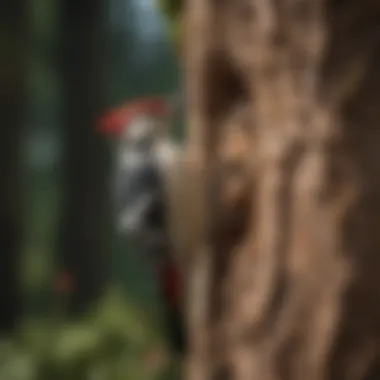

Identifying Woodpecker Damage
Identifying woodpecker damage is crucial for homeowners facing issues with these birds. Understanding the signs of their presence helps in taking timely actions to mitigate further destruction to property. Woodpeckers may appear charming, but their pecking can lead to serious structural problems. If left unchecked, their activity can result in costly repairs. By recognizing the damage early, homeowners can enact the remedies effectively before extensive harm occurs. This section will guide you through the common signs of woodpecker infestation, types of damage they cause, and how to evaluate severity.
Common Signs of Infestation
The first step in managing woodpecker issues involves observing for signs of their presence. Look out for:
- Drilling Holes: Small holes are usually the first indication. Woodpeckers make these to find insects. The size of the holes can vary depending on the type of woodpecker.
- Chip Debris: Wood chips on the ground may indicate pecking activity. This debris is often found beneath areas where woodpeckers have been active.
- Sounds of Drumming: This is a distinct behavior. The drumming is self-performed to attract mates or mark territory. If you hear repetitive, rhythmic sounds, you may have a woodpecker nearby.
- Visual Sightings: Spotting the bird itself is a clear sign. Woodpeckers often perch on trees or the sides of homes while searching for food or nesting sites.
Recognizing these signs quickly allows homeowners to take the necessary steps to deter these birds effectively.
Types of Woodpecker Damage
Understanding the types of damage caused by woodpeckers helps in addressing concerns appropriately. Common damage includes:
- Holes in Siding: Woodpeckers often drill into wooden siding, which can leave your house vulnerable to moisture intrusion and pests.
- Damaged Trees: Infestation can weaken trees. They may create holes for nesting, leading to tree decay over time.
- Roof Damage: Roofs made from wood are targeted by woodpeckers. They may peck at rafters and shingles, necessitating potential costly repairs.
- Pecking on Eaves and Corners: This activity can cause significant structural damage. Eaves are often targeted as they are prime spots for insects and larvae.
Recognizing these types of damage will be essential for homeowners to initiate the right interventions.
Evaluating the Severity of Damage
Once damage is observed, evaluating its severity is important before deciding on remedies. Take the following points into account:
- Extent of Holes: Measure how deep and how wide the holes are. Small holes may not be urgent, but larger holes could signify more serious issues.
- Location of Damage: Certain areas may indicate infestations when located in vulnerable spots like eaves or siding. Damage here may be more critical as it contributes to potential structural issues.
- Impact on Property: Consider whether damage affects the integrity of the home. Are there signs of water leaks or mold happening due to holes?
- Insect Presence: Check if other pests are present around the damaged areas. This can signal a bigger issue that may attract more woodpeckers.
By evaluating the severity accurately, homeowners can prioritize actions to repair damage effectively and implement deterrents.
The quicker you identify and assess woodpecker damage, the better you can safeguard your home from further issues.
Home Remedies to Deter Woodpeckers
Deterring woodpeckers with home remedies is vital for homeowners. Woodpeckers can cause significant damage. They peck at the exterior of homes, looking for insects or creating nesting sites. Traditional methods often involve harmful measures, which is why home remedies are appealing. Not only are these strategies effective, but they are also eco-friendly. This section explores various harmless tactics. These methods allow property owners to manage avian visitors responsibly.
Shiny Objects as Deterrents
Woodpeckers are highly visual creatures. They tend to shy away from shiny surfaces. Using shiny objects can be an effective deterrent. Hanging reflective materials can disrupt their comfort. Items like aluminum foil strips, reflective tape, or old CDs can be used. These should be hung where woodpeckers typically visit. The movement and light reflection help to scare them off.
Consider placing these shiny objects near eaves, windows, and trees. Regularly changing their position may enhance effectiveness, as woodpeckers get used to static deterrents.
Noise-Making Devices
Woodpeckers avoid areas with loud sounds. Noise-making devices can help deter these birds. Options include wind chimes, metallic objects, or purchased noise devices. These devices create sounds that woodpeckers find uncomfortable.
Place noise makers around active pecking spots. The goal is to make the environment feel less safe for woodpeckers. Homeowners can also engage with neighbors. Grouping efforts increases overall noise levels and effectiveness against the birds.
Vegetative Barriers
A natural barrier can provide a physical deterrent to woodpeckers. Planting dense shrubs or certain trees can minimize accessibility to your home. Thick vegetation not only blocks woodpecker access but also provides habitat for other birds.
Some preferred plants include holly, juniper, or thick ornamental grasses. These plants create a less appealing landscape for woodpeckers. Make sure to place them strategically near the areas they frequent.
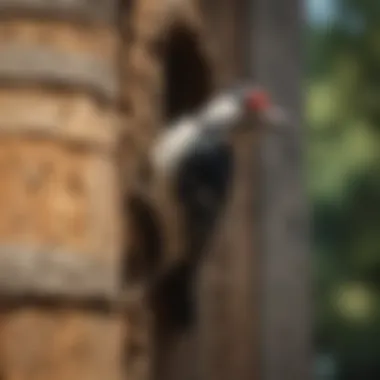

Spray Solutions with Natural Ingredients
Homemade sprays can effectively deter woodpeckers. A mixture of water with natural ingredients can create an unpleasant taste for the birds. Common ingredients include vinegar, hot pepper, or citrus peels.
Combine water with these ingredients in a spray bottle. Spraying this mixture on wooden surfaces may discourage pecking. It's essential to apply the spray regularly. Weather conditions may wash away the mixture, reducing its effectiveness.
Applying these remedies consistently can change woodpecker behavior over time. Remember to ensure these solutions do not harm the birds or the environment.
Key Takeaway: Discovering and implementing home remedies can help protect your property from woodpecker damage. Using non-invasive, natural methods is both effective and beneficial.
Physical Barriers and Modifications
The approach of using physical barriers and modifications proves to be quite effective in deterring woodpeckers. These measures focus on creating obstacles that prevent woodpeckers from accessing areas of your property they tend to damage. By implementing these strategies, homeowners can significantly reduce the chances of woodpecker infestation and protect their property.
Physical barriers not only serve to block access but also alter the environment in ways that make it less appealing for woodpeckers. The impact can be substantial if these modifications are effectively integrated into your home’s structure.
Installing Visual Barriers
Visual barriers can be particularly useful in keeping woodpeckers at bay. These barriers create a visual disruption that can disorient birds flying towards your property. Common types of visual barriers include reflective surfaces, such as aluminum foil or reflective tape, hung in areas where woodpeckers are most active.
The placement and arrangement of these barriers can also play a role in their effectiveness. It's important to regularly change their position and appearance, as birds tend to adapt to stationary objects quickly. This adaptability means that a dynamic approach to visual barriers can yield better results.
Repairing Damaged Areas
Protecting your property involves addressing any existing damage that may attract woodpeckers. Repairing damaged areas is a critical step in this process. This includes two key actions: sealing holes and applying protective coatings.
Sealing holes
Sealing holes is essential to prevent woodpeckers from using existing gaps as entry points to nest or forage. When holes are sealed effectively, it not only keeps woodpeckers from accessing these areas but also enhances the home’s overall integrity.
A key characteristic of sealing holes is its ease of application. Homeowners can use caulk or wood filler to patch openings. This method is beneficial because it is often low-cost and does not require specific expertise. The unique feature of sealing holes lies in its adaptability to various materials, such as siding or wooden structures. However, one must consider that merely sealing holes does not address the underlying causes that drew woodpeckers in initially, such as wood decay or insects. Therefore, it should be part of a broader strategy.
Applying protective coatings
Applying protective coatings is another effective strategy in the management of woodpecker activity. These coatings can discourage pecking by creating a less inviting surface. This method may involve using textured paints or specialized wood preservatives that make it difficult for woodpeckers to grasp surfaces.
The key characteristic of applying protective coatings is its long-lasting effect. Unlike temporary visual deterrents, a good coating can provide extended protection against woodpecker damage. However, homeowners should anticipate regular maintenance to ensure its effectiveness remains high. A unique feature of these coatings is their ability to blend seamlessly with existing color schemes, making it a visually appealing solution. Nevertheless, the upfront cost may be higher than simpler alternatives, which can be a consideration for budget-conscious homeowners.
Using Netting or Screens
Netting or screens can serve as an effective physical barrier against woodpeckers. These structures can be installed over vulnerable areas, such as trees or wooden surfaces, to stop woodpeckers from gaining access. The advantage of using netting lies in its versatility and availability, as it can be purchased at many gardening stores or online.
When choosing netting or screens, it is important to ensure that they are properly anchored and don’t create additional hazards for other wildlife. The effectiveness of this method can also depend on the size of the netting’s openings; smaller openings may be necessary to keep woodpeckers from reaching through.
Utilizing Wild Bird Feeders
Wild bird feeders can serve as an effective method to manage woodpecker presence. While woodpeckers may seem determined to forage on your home, utilizing wild bird feeders offers several benefits that can help redirect their interest away from your property. By carefully designing and placing these feeders, you can attract other bird species that will occupy the space, making it less appealing for woodpeckers.
Feeder systems not only enrich your garden ecosystem but also provide visual distraction. This is particularly important in areas where woodpeckers tend to invade. Establishing a bird-friendly environment supports biodiversity and can enhance your outdoor experience.
Adjusting Feeder Placement
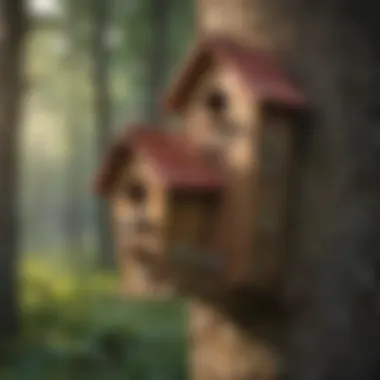

When setting up wild bird feeders, their placement is crucial. You should keep feeders away from trees or structures that woodpeckers can easily perch on. Ideally, place feeders at least 20-30 feet from wood surfaces to minimize the chance of attracting woodpeckers. Instead, aim for areas that are visible yet not easily accessible to these birds.
Consider creating a more open space with less cover. Use bird feeders that are designed for smaller birds, as these likely will not attract woodpeckers as much. Pay attention to local feeding patterns during different seasons, and adjust the feeders according to that.
Choosing Bird Food Wisely
Selecting the right bird food can influence which birds visit your feeders. Woodpeckers typically prefer suet, nuts, and larger seeds. Thus, avoiding these types of food can deter them. Instead, consider offering smaller seeds, such as nyjer or sunflower seeds. These types of food appeal more to finches, sparrows, and other non-woodpecker bird species.
Use mixed birdseed that lacks suet or nuts to keep woodpeckers uninterested. This way, you draw in small songbirds who often feel more comfortable in the presence of other birds. Remember, maintaining the quality and freshness of bird food is essential, as this ensures your backyard remains lively and appealing to desirable species.
By adopting thoughtful feeder placement and wise food selections, homeowners can create a visual and ecological barrier against woodpeckers without resorting to harmful solutions.
In summary, effectively utilizing wild bird feeders not only manages woodpecker interference but also enhances the overall enjoyment of outdoor spaces. The combination of strategic feeder placement and appropriate food choices can serve as a humane deterrent, while still inviting a host of other birds to your garden.
Engaging Professional Help
When dealing with the persistent issue of woodpeckers, engaging professional help can be a vital step for homeowners. While various home remedies can be effective, they may not always suffice, especially when the problem escalates. Professionals bring expertise and experience, providing tailored solutions that address specific concerns. Moreover, they can assess the seriousness of the infestation, ensuring that necessary actions are taken without delay.
When to Seek Assistance
Homeowners should consider seeking professional help when the situation reaches a point where DIY methods prove ineffective. If woodpecker activity continues despite implementing recommended remedies, it is wise to consult an expert. Additionally, if significant damage is caused to the structural integrity of the home, professional intervention is essential. This is especially true for old homes or those made with vulnerable materials where increased risk of long-term damage exists.
Moreover, if there are concerns about the legal implications of dealing with woodpeckers, a professional can guide homeowners in accordance to regulations protecting these birds. Engaging a specialist ensures that approaches used are humane and compliant with laws regarding bird protection.
Evaluating Pest Control Services
When looking for pest control services, evaluation is key to finding an effective solution for woodpecker problems. It is important to consider the certification and reputation of the service providers available in your area. A reputable pest control service holds necessary certifications, ensuring they follow ethical practices and understand local regulations. This protects your property while adhering to humane treatment of wildlife.
Certification and Reputation
Certification and reputation are fundamental factors to consider. Certified professionals typically possess the necessary training in wildlife management and control methods, which translates into safer and more effective results. A well-reputed service often has positive client reviews, indicating a track record of successful interventions.
Moreover, when you engage certified pest control services, you are more likely to receive a comprehensive assessment and tailored solution to your issue. These professionals will incorporate effective strategies that minimize harm to woodpeckers while protecting your home. However, keep in mind that a reputable brand may be more costly. This investment is often worthwhile for a guaranteed solution and peace of mind.
Methods and Approaches
Next, examining the methods and approaches utilized by pest control services is essential in determining the best fit for addressing woodpecker issues. Services that use a combination of humane practices, such as visual deterrents and sound-based repellents, demonstrate a more considerate approach to wildlife management. It is beneficial to discuss these methods during the initial consultation.
For example, some professionals may use specialized noise devices to repel woodpeckers without harming them. This aligns with the goal of ethical wildlife management while still effectively deterring the birds. On the other hand, reliance on chemical repellents may be less favorable due to potential harm posed to other wildlife or the environment. Thus, understanding the unique features of their proposed methods can help you make a more informed decision when selecting a pest control service.
Epilogue
The conclusion serves as a critical component of this article by encapsulating the key insights and practical steps outlined throughout the text. Understanding how to effectively deter woodpeckers is not just about protecting one’s property; it encompasses several broader considerations such as animal welfare and environmental impact. By employing humane methods, homeowners can manage pest issues without resorting to harm, thus maintaining a balance between human needs and wildlife preservation.
Summary of Key Points
- Home remedies can effectively deter woodpeckers without killing or harming them.
- Strategies include utilizing shiny objects, noise-making devices, and physical barriers.
- Engaging professional help might be necessary when home remedies seem ineffective.
- Understanding woodpecker behavior is essential for effective control.
- Prevention, coupled with immediate action, can minimize damage.
Final Thoughts on Woodpecker Management
Managing woodpeckers requires mindfulness and understanding. An essential element in this approach is recognizing their natural habits and motivations. The methods discussed in this article offer a blend of traditional wisdom and modern tactics that respect the ecological role of woodpeckers while safeguarding property.
Ultimately, effectiveness lies in persistence and adaptability. Homeowners should monitor results and be willing to adjust strategies based on observed woodpecker behaviors. Employing an array of techniques not only enhances the chances of success but also fosters a humane environment where both homeowners and wildlife can coexist peacefully.
"Effective woodpecker management combines kindness with ingenuity."
This balance is crucial for sustainable living, and by adopting these practices, homeowners can make meaningful contributions to both their households and their local ecosystems.

